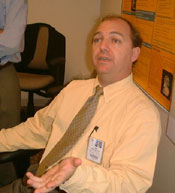Program Information
Adapt-A-Thon - Texas Hold'em Invitational

M Kessler
K Brock
J Pouliot
L Dong
M Kessler1*, K Brock1*, J Pouliot2*, L Dong3*, (1) The University of Michigan, Ann Arbor, MI, (2) UC San Francisco, San Francisco, CA, (3) Scripps Proton Therapy Center, San Diego, CA
Presentations
MO-E-BRD-1 Monday 1:45PM - 3:45PM Room: Ballroom DSoftware tools for image-based adaptive radiotherapy such as deformable image registration, contour propagation and dose mapping have progressed beyond the research setting and are now commercial products available as part of both treatment planning systems and stand-alone applications. These software tools are used together to create clinical workflows to detect, track and evaluate changes in the patient and to accumulate dose. Deviations uncovered in this process are used to guide decisions about re-planning/adaptation with the goal of keeping the delivery of prescribed dose “on target" throughout the entire course of radiotherapy. Since the output from one step of the adaptive process is used as an input for another, it is essential to understand and document the uncertainty associated with each of the step and how these uncertainties are propagated. This in turn requires an understanding how the underlying tools work. Unfortunately, important details about the algorithms used to implement these tools are scarce or incomplete, too often for competitive reasons. This is in contrast to the situation involving other basic treatment planning algorithms such as dose calculations, where the medical physics community essentially requires vendors to provide physically important details about their underlying theory and clinical implementation. Vendors should adopt this same level of information sharing when it comes to the tools and techniques for image guided adaptive radiotherapy. The goal of this session is to start this process by inviting vendors and medical physicists to discuss and demonstrate the available tools and describe how they are intended to be used in clinical practice. The format of the session will involve a combination of formal presentations, interactive demonstrations, audience participation and some friendly “Texas style†competition.
Learning Objectives:
1. Understand the components of the image-based adaptive radiotherapy process.
2. Understand the how these components are implemented in various commercial systems.
3. Understand the different use cases and workflows currently supported these tools.
Contact Email:

